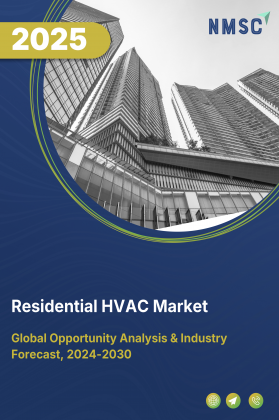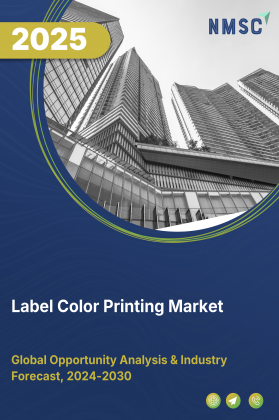
Residential HVAC Market by Equipment (Room‐Level Air Conditioners, Split Air Conditioners, Packaged & Central AC Units, Chillers and Others), by System Type (Centralized Systems, Decentralized Systems, and Hybrid Systems), by Implementation Type (New Construction Buildings, Retrofit Buildings), by Technology (Inverter Technology, Non-Inverter Technology, and Others), by Capacity (Up to 1.5 Ton, 1.5–3 Ton, 3–5 Ton, and Others)– Global Opportunity Analysis and Industry Forecast 2025–2030.
Industry Overview
The global Residential HVAC Market size was valued at USD 104.50 billion in 2024, with an estimation of USD 122.47 billion in 2025 and is predicted to reach USD 154.22 billion by 2030 with a CAGR of 5.16% from 2025-2030.
The market serves accommodations such as hotels, motels, vacation rentals, and resorts, where growing urbanization is driving increased construction of new properties that require efficient HVAC systems. As more travelers seek comfortable and healthy indoor environments, there is rising demand for HVAC solutions that prioritize energy efficiency and sustainability, helping reduce utility costs and carbon footprints.
Additionally, concerns about indoor air quality, especially in urban settings with higher pollution, are prompting the adoption of advanced air purification, humidity control, and ventilation technologies in these accommodations. Together, these factors are encouraging property owners and operators to invest in modern HVAC systems that enhance guest comfort while meeting evolving regulatory standards and environmental goals.
Growing Urbanization and New Housing Developments Boost the Market Growth
Rapid urban expansion and increasing demand for new residential properties are key drivers for the residential HVAC market growth. According to the United Nations’ World Urbanization Prospects 2023, about 57% of the global population now resides in urban areas, and this is projected to rise to 68% by 2050. This accelerated urbanization fuels the construction of new homes, apartments, and multi-family residential buildings that require efficient HVAC systems to ensure comfort and air quality.
Rising Demand for Energy-Efficient Systems Drives Market Expansion
Increasing awareness about energy conservation and the growing emphasis on sustainability are driving consumers to upgrade or install modern HVAC systems that offer improved energy efficiency and reduce utility bills. Governments worldwide are introducing strict energy efficiency regulations and providing incentives such as rebates and tax credits to encourage adoption of energy-saving HVAC technologies.
This focus on lowering carbon footprints and reducing electricity costs motivates homeowners to prefer HVAC units with high efficiency ratings and advanced features. Additionally, rising electricity prices in many regions push consumers to invest in systems that deliver long-term cost savings through lower power consumption and smart energy management.
Rising Awareness About Indoor Air Quality and Health
Growing concerns about indoor air pollution and its direct impact on respiratory health and overall wellbeing are driving homeowners to invest in residential HVAC systems that do more than regulate temperature. Especially in urban areas with higher pollution levels, there is a strong demand for HVAC units equipped with advanced air purification technologies such as HEPA filters, UV sterilization, and activated carbon filters that effectively reduce airborne contaminants, allergens, and volatile organic compounds (VOCs).
In addition to improving air quality, features like humidity control and enhanced ventilation help prevent mold growth and maintain comfortable living environments. This shift is also supported by increasing government regulations and health guidelines focused on indoor air quality, encouraging the installation of more sophisticated HVAC solutions.
As a result, the focus on creating healthier indoor environments has become a significant growth driver in the residential HVAC market expansion, pushing manufacturers to innovate and offer systems that address both comfort and health concerns.
Price Volatility of Raw Materials Restrains the Growth of the Market
Fluctuations in the prices of key raw materials pose a significant challenge to the growth of the market. Factors such as inflation and supply chain disruptions have led to rising costs for essential materials like steel, copper, and aluminum. This increase in raw material expenses drives up manufacturing costs for HVAC systems, putting considerable pressure on small and mid-sized residential HVAC manufacturers. As their profit margins shrink, these companies face difficulties in allocating funds for innovation and research & development, ultimately slowing the overall market growth.
IoT Integration Creates Ample Opportunities for the Market
The integration of Internet of Things (IoT) technology is unlocking substantial opportunities within the market. IoT-enabled HVAC systems offer remote control capabilities, improved energy efficiency, and predictive maintenance features. By embedding sensors and smart devices into residential HVAC units, homeowners monitor and adjust their systems remotely, optimize energy consumption, and address potential maintenance issues before they become costly problems.
This not only enhances user comfort and convenience but also lowers energy bills and extends the lifespan of HVAC equipment. As demand increases for smarter, more energy-efficient homes, IoT integration is set to be a major growth driver for the market.
Market Segmentation and Scope of Study
The residential HVAC market report is divided on the basis of equipment, system type, implementation type, technology, capacity, installation/mounting, and region. On the basis of equipment, the market is grouped into room-level air conditioners, split air conditioners, packaged & central AC units, chillers, heating equipment, ventilation equipment, humidity control, cooling towers, and controls & thermostats. On the basis of system type, the market is categorized into centralized systems, decentralized systems, and hybrid systems. On the basis of implementation type, the market is grouped into new construction buildings and retrofit buildings. On the basis of technology, the market is categorized into inverter technology, non-inverter technology, smart/IoT-enabled, and conventional. On the basis of capacity, the market is segmented into up to 1.5 ton, 1.5–3 ton, 3–5 ton, and above 5 ton. Regional breakdown and analysis of each of the aforesaid segments include regions comprising North America, Europe, Asia-Pacific, and Rest of the World.
Geographical Analysis
North America remains one of the largest markets for residential HVAC systems, driven by high consumer awareness, stringent energy efficiency regulations, and widespread adoption of advanced HVAC technologies. According to the U.S. Energy Information Administration (EIA, 2024), approximately 65% of U.S. households have central air conditioning systems, with ongoing replacement cycles supporting steady demand. The region also benefits from government incentives promoting energy-efficient HVAC upgrades. The growing trend of smart homes further boosts adoption, particularly in the U.S. and Canada, where consumers prioritize comfort and energy savings.
Europe's residential HVAC market share is being significantly influenced by ambitious funding and policy efforts aimed at modernizing its housing stock. At the EIB Group Forum in March 2025, the European Investment Bank unveiled its Action Plan for Affordable and Sustainable Housing, which includes a new housing one-stop-shop portal designed to provide centralized access to financing and advisory services.
This initiative is part of an approximately $11 billion USD investment package earmarked for the next two years, intended to support the construction of affordable homes, the renovation of existing housing, and the promotion of energy-efficient and innovative construction materials and practices. Together, these efforts are expected to facilitate the delivery of 1.5 million new or refurbished housing units across Europe and serve as foundational elements for a pan-European investment platform inviting broader financial participation.
The APAC market is the fastest growing globally, fueled by rapid urbanization, expanding middle-class populations, and increasing disposable incomes in key economies such as India and China. India’s per capita disposable income was US$ 2.11 thousand in 2019, rising to US$ 2.54 thousand in 2023, and is projected to reach US$ 4.34 thousand by 2029.
This steady growth in household income enhances affordability for residential HVAC systems and encourages investments in energy-efficient and smart HVAC technologies. Coupled with large-scale residential construction and government housing initiatives, these economic trends are driving robust demand and market expansion across the APAC region.
The Rest of the World (RoW) region, encompassing Latin America, the Middle East, and Africa, exhibits varied growth trends in the market, influenced by diverse climates and economic landscapes. Increasing urbanization and enhanced infrastructure development in countries like Brazil, South Africa, and the GCC are driving demand, especially for cooling solutions suited to warmer environments. Nevertheless, the market faces challenges such as high price sensitivity, irregular energy supply, and distinct consumer preferences, leading to uneven adoption across these areas. Despite these obstacles, awareness around smart and energy-efficient residential HVAC systems is rising, boosting interest in advanced solutions that offer comfort and cost savings.
Strategic Innovations Adopted by Key Players
Major residential HVAC industry players are accelerating global expansion through upscale brand launches, service diversification, and strategic partnerships.
-
In August 2025, Bosch took a major step in the HVAC market by acquiring Johnson Controls-Hitachi Air Conditioning businesses, significantly expanding its global HVAC portfolio. By integrating these assets into Bosch Home Comfort, the company has broadened its product range, strengthened its presence in India, and scaled its global distribution channels. This strategic acquisition repositions Bosch as a comprehensive HVAC competitor with a strong foothold in Europe and rapidly growing influence across Asia.
-
In April 2025, Carrier has intensified its focus on cold-climate electrification by successfully completing the DOE Cold-Climate Heat Pump Challenge. The company also launched a high-efficiency cold-climate heat pump lineup featuring its Infinity and Greenspeed technologies and reintroduced geothermal products. These strategic moves enhance Carrier’s energy-efficiency reputation and strengthen its dealer network across North America and Europe, boosting brand visibility and positioning the company for sustained growth in the electrified HVAC market.
-
In March 2024, Panasonic unveiled new commercial and residential air-to-water heat pumps along with the OASYS residential central system for the U.S. market. Additionally, the company advanced joint heat-pump water-heater projects in partnership with A. O. Smith. These initiatives reflect Panasonic’s strategy to integrate HVAC and water-heating solutions, positioning itself as a comprehensive home-energy provider while strengthening installer partnerships.
Key Benefits
-
The report provides quantitative analysis and estimations of the industry from 2025 to 2030, that assists in identifying the prevailing market opportunities.
-
The study comprises a deep-dive analysis of the current and future residential HVAC market trends to depict prevalent investment pockets in the sector.
-
Information related to key drivers, restraints, and opportunities and their impact on the market is provided in the report.
-
Competitive analysis of the players, along with their market share is provided in the report.
-
SWOT analysis and Porters Five Forces model is elaborated in the study.
-
Value chain analysis in the market study provides a clear picture of roles of stakeholders.
Residential HVAC Market Key Segments
By Equipment
-
Room‐Level Air Conditioners
-
Window
-
Portable
-
Cassette (ceiling-mounted)
-
Floor-standing console
-
-
Split Air Conditioners
-
Single-split (1 indoor + 1 outdoor)
-
Multi-split (≥2 indoors + 1 outdoor)
-
VRF/VRV
-
-
Packaged & Central AC Units
-
Rooftop packaged units
-
Self-contained packaged units
-
Central chiller and AHU systems
-
-
Chillers
-
Air-cooled
-
Water-cooled
-
Absorption
-
-
Heating Equipment
-
Heat Pumps
-
Furnaces
-
Boilers
-
Unit Heaters
-
-
Ventilation Equipment
-
Air Handling Units (AHUs)
-
Fans & Blowers
-
Air Filtration Systems
-
Air Purification Systems
-
-
Humidity Control
-
Humidifiers
-
Dehumidifiers
-
-
Cooling Towers
-
Controls & Thermostats
By System Type
-
Centralized Systems
-
Decentralized Systems
-
Hybrid Systems
-
By Implementation Type
-
New Construction Buildings
-
Retrofit Buildings
By Technology
-
Inverter Technology
-
Non-Inverter Technology
-
Smart/IoT-enabled
-
Conventional
By Energy Efficiency
-
1 Star
-
2 Star
-
3 Star
-
4 Star
-
5 Star
By Capacity
-
Up to 1.5 Ton
-
1.5-3 Ton
-
3-5 Ton
-
Above 5 Ton
By Installation/Mounting
-
Wall-mounted
-
Ceiling-mounted
-
Floor-standing
-
Ducted
-
Window-mounted
-
Portable
By Region
-
North America
-
The U.S
-
Canada
-
Mexico
-
-
Europe
-
The UK
-
Germany
-
France
-
Italy
-
Spain
-
Denmark
-
Netherlands
-
Finland
-
Sweden
-
Norway
-
Russia
-
Rest of Europe
-
-
Asia-Pacific
-
China
-
Japan
-
India
-
South Korea
-
Australia
-
Indonesia
-
Singapore
-
Taiwan
-
Thailand
-
Rest of Asia-Pacific
-
-
Rest of the World
-
Latin America
-
Middle East
-
Africa
-
Key Players
-
Carrier Global Corporation
-
Daikin Industries
-
Electrolux AB
-
Fujitsu General America
-
Haier Group
-
Lennox International
-
LG Electronics
-
Midea Group Co., Ltd.
-
Mitsubishi Electric Corporation
-
Samsung HVAC, LLC
-
Whirlpool Corporation
-
Trane Technologies
-
Rheem Manufacturing Company
Report Scope and Segmentation
|
Parameters |
Details |
|
Market Size in 2025 |
USD 122.47 Billion |
|
Revenue Forecast in 2030 |
USD 154.22 Billion |
|
Growth Rate |
CAGR of 5.16% from 2025 to 2030 |
|
Analysis Period |
2024–2030 |
|
Base Year Considered |
2024 |
|
Forecast Period |
2025–2030 |
|
Market Size Estimation |
Billion (USD) |
|
Growth Factors |
|
|
Countries Covered |
28 |
|
Companies Profiled |
15 |
|
Market Share |
Available for 10 companies |
|
Customization Scope |
Free customization (equivalent to up to 80 working hours of analysts) after purchase. Addition or alteration to country, regional, and segment scope. |
|
Pricing and Purchase Options |
Avail customized purchase options to meet your exact research needs. |

















 Speak to Our Analyst
Speak to Our Analyst
























